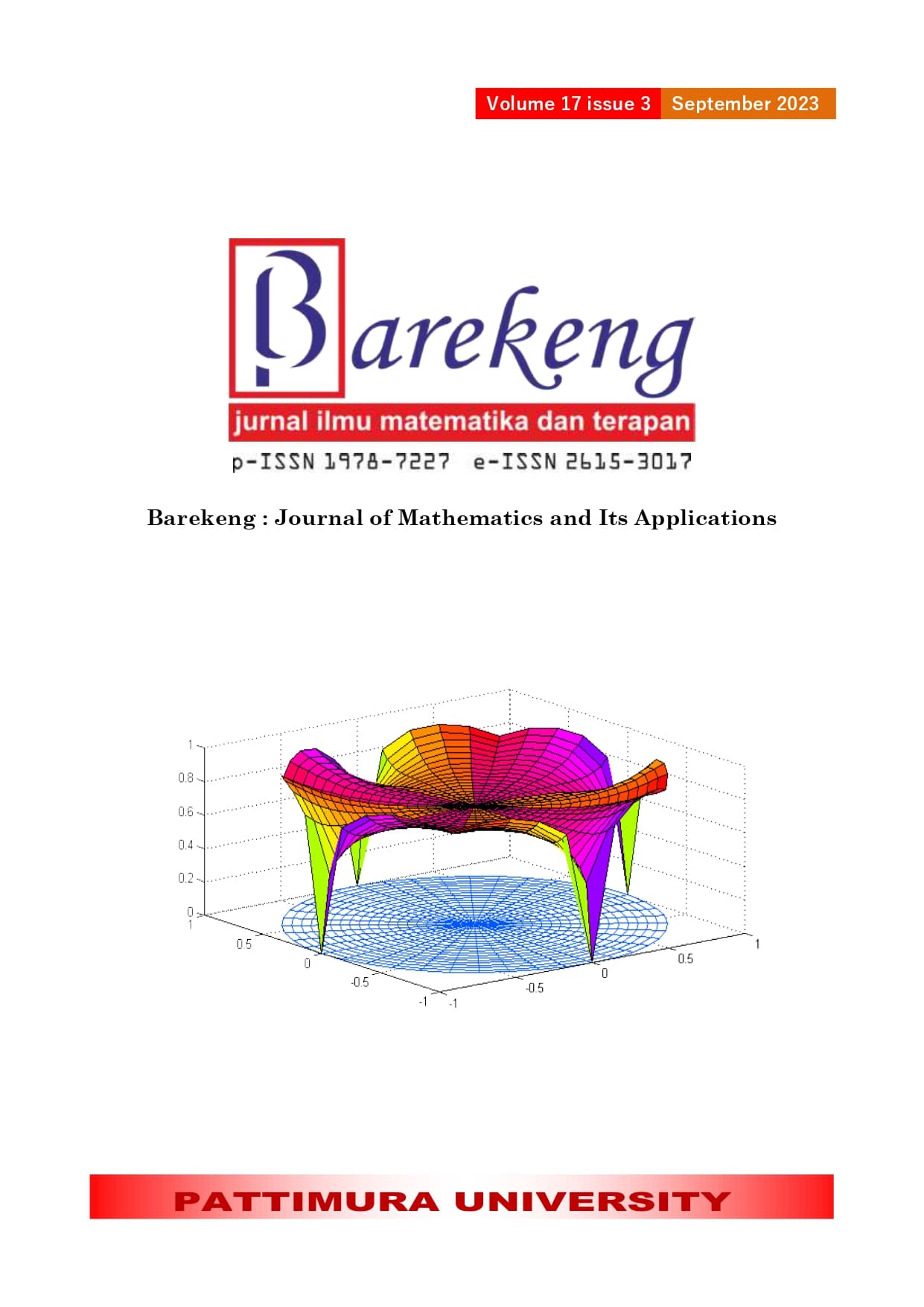POISSON REGRESSION MODELS TO ANALYZE FACTORS THAT INFLUENCE THE NUMBER OF TUBERCULOSIS CASES IN JAVA
Abstract
Tuberculosis is an infectious disease and one of the world's top 10 highest causes of mortality in Indonesia. Based on this fact, it is necessary to study what factors affect number of tuberculosis cases. The number of tuberculosis cases as dependent variable is a count data that generally analyzed using Poisson regression. However, equidispersion assumption must be met, so Generalized Poisson Regression and Negative Binomial Regression are applied if the assumption is not met. Spatial aspects can be considered so Geographically Weighted Generalized Poisson Regression and Geographically Weighted Negative Binomial Regression were also conducted. Four models were built to evaluate relationship between number of tuberculosis cases and factors affecting it in Java in 2020. The explanatory variables are population density, percentage of children receiving BCG immunization, percentage of poor people, percentage of eligible drinking water facilities, percentage of family cards with access to proper sanitation, percentage of public places meet health requirements, and percentage of food management places meet hygienic requirements. This study shows that the best model for modeling the data is GWNBR with 2 groups of significant explanatory variables. Seven explanatory variables are statistically significant in 88 districts and six explanatory variables statistically significant in 12 districts.
Downloads
References
Kemenkes RI, “InfoDATIN Tuberkulosis 2018,” Pusat Data dan Informasi Kementerian Kesehatan RI, Jakarta, 2018. [Online]. Available: https://pusdatin.kemkes.go.id/article/view/18101500001/infodatin-tuberkulosis-2018.html
Kompaspedia, “Sebaran Kasus Tuberkulosis di Indonesia,” 2021. https://kompaspedia.kompas.id/baca/infografik/peta-tematik/sebaran-kasus-tuberkulosis-di-indonesia
B. Irawati, “Perbandingan Analisis Generalized Poisson Regression (GPR) dan Regresi Binomial Negatif untuk Mengatasi Overdispersi Studi Kasus: Pemodelan Jumlah Kasus Kanker Serviks di Jawa Timur,” Jurnal Matematika, vol. 2, no. 2, pp. 13–24, 2012.
E. U. L. Fitri, “Pemodelan Faktor-Faktor yang Mempengaruhi Jumlah Kasus Tuberkulosis di Jawa Timur Menggunakan Metode Geographically Weighted Generalized Poisson Regression dan Geographically Weighted Negative Binomial Regression,” Institut Teknologi Sepuluh Nopember, Surabaya, 2017.
S. Indahwati and M. Salamah, “Analisis Faktor-Faktor yang Memengaruhi Jumlah Kasus Tuberculosis di Surabaya Tahun 2014 Menggunakan Geographically Weighted Negative Binomial Regression,” Jurnal Sains dan Seni ITS, vol. 5, no. 2, 2016.
A. S. N. Zaina, R. S. Pontoh, and B. Tantular, “Pemodelan Dan Pemetaan Penyakit TB Paru di Kota Bandung Menggunakan Geographically Weighted Negative Binomial Regression: Studi Kasus Dinas Kesehatan Kota Bandung,” in E-Prosiding Seminar Nasional Statistika| Departemen Statistika FMIPA Universitas Padjadjaran, 2021, p. 8.
S. Noorcintanami, Y. Widyaningsih, and S. Abdullah, “Geographically weighted models for modelling the prevalence of tuberculosis in Java,” J Phys Conf Ser, vol. 1722, no. 1, p. 012089, Jan. 2021, doi: 10.1088/1742-6596/1722/1/012089.
Dinas Kesehatan Provinsi Jawa Barat, Profil Kesehatan Provinsi Jawa Barat. Bandung, 2020. [Online]. Available: https://diskes.jabarprov.go.id/assets/unduhan/Profil%20Kesehatan%20Jawa%20Barat%20Tahun%202020.pdf
Dinas Kesehatan Provinsi Jawa Tengah, Profil Kesehatan Provinsi Jawa Tengah. Semarang, 2020. [Online]. Available: https://dinkesjatengprov.go.id/v2018/dokumen/Profil2020/mobile/index.html
Dinas Kesehatan Provinsi Jawa Timur, Profil Kesehatan Provinsi Jawa Timur. Surabaya, 2020. [Online]. Available: https://dinkes.jatimprov.go.id/userfile/dokumen/PROFIL%20KESEHATAN%202020.pdf
BPS Provinsi Jawa Barat, “Persentase Penduduk Miskin (Persen), 2019-2021,” Badan Pusat Statistik Provinsi Jawa Barat, 2021. https://jabar.bps.go.id/indicator/23/51/1/persentase-penduduk-miskin.html
BPS Provinsi Jawa Tengah, “Kemiskinan, 2019-2021,” Badan Pusat Statistika Provinsi Jawa Tengah, 2021. https://jateng.bps.go.id/indicator/23/34/1/kemiskinan.html
BPS Provinsi Jawa Timur, “Jumlah dan Persentase Penduduk Miskin di Provinsi Jawa Timur Menurut Kabupaten/Kota, 2017-2021,” Badan Pusat Statistika Provinsi Jawa Timur, 2021. https://jatim.bps.go.id/indicator/23/421/1/jumlah-penduduk-miskin-menurut-kabupaten-Kota-di-jawa-timur.html
D. C. Montgomery, E. A. Peck, and G. G. Vining, Introduction to linear regression analysis. John Wiley & Sons, 2021.
P. McCullagh, Generalized linear models. Routledge, 2019.
F. Famoye, J. T. Wulu, and K. P. Singh, “On the generalized Poisson regression model with an application to accident data,” Journal of Data Science, vol. 2, no. 3, pp. 287–295, 2004.
F. Famoye, “Restricted generalized poisson regression model,” Commun Stat Theory Methods, vol. 22, no. 5, pp. 1335–1354, Jan. 1993, doi: 10.1080/03610929308831089.
J. M. Hilbe, Negative binomial regression. Cambridge University Press, 2011.
L. Anselin, Spatial econometrics: methods and models, vol. 4. Springer Science & Business Media, 1988.
A. R. da Silva and T. C. V. Rodrigues, “Geographically weighted negative binomial regression—incorporating overdispersion,” Stat Comput, vol. 24, pp. 769–783, 2014.
H. Akaike, “Information theory and an extension of the maximum likelihood principle,” Selected papers of hirotugu akaike, pp. 199–213, 1998.
Copyright (c) 2023 Zalfa Alifah Budiawan, Yekti Widyaningsih

This work is licensed under a Creative Commons Attribution-ShareAlike 4.0 International License.
Authors who publish with this Journal agree to the following terms:
- Author retain copyright and grant the journal right of first publication with the work simultaneously licensed under a creative commons attribution license that allow others to share the work within an acknowledgement of the work’s authorship and initial publication of this journal.
- Authors are able to enter into separate, additional contractual arrangement for the non-exclusive distribution of the journal’s published version of the work (e.g. acknowledgement of its initial publication in this journal).
- Authors are permitted and encouraged to post their work online (e.g. in institutional repositories or on their websites) prior to and during the submission process, as it can lead to productive exchanges, as well as earlier and greater citation of published works.






1.gif)



